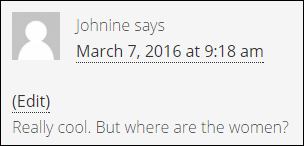After posting my screencast on Creating Pictogram People in PowerPoint using 3 Shapes, I looked at the samples I shared and realized they were all quite “mannish.” Generally, I think pictogram people, due to their very nature, should be gender-less. They are just shapes put together to represent a person. This makes it easy when developing something like e-learning courses where you want a non-gender specific representation of a person. Like, for instance, this: 
But is that image really gender-less? Do we look at the head with no hair and automatically assume male? Do we end up taking a supposedly gender neutral image and assign a gender to it automatically? We take pictograms and tweak them to have neckties (male) and dresses (female) to be simple representations of gender. Is that right or wrong? Should we do that?
I don’t know if there is a “right” or a “wrong.” I think you can try to ascribe a gender-less person by using the generic image as shown above. But, sometimes you want to have male and female representations in your pictograms. However, in those instances, make sure you have both genders represented. In my original post, I unconsciously created people that looked male (e.g., bow tie, neck tie, v-neck, etc.). See below.

As I mentioned, I realized this soon after posting, but I also got called out (thanks Johnine) in a comment on the post. Rightly so, I might add.

So, I set about to create some female pictogram people. I’ll share the source file for those too. I’m not sure how I did on representing femaleness. I found it hard to try to make these three-quarter people look female. One limitation I placed on myself for both sets of people was to keep the head bare (just an oval). I found myself wanting to add “female” things to the head, like a bow (I know, these are supposed to be women, not 6 yr-olds) or some kind of hair that would look female. Again, this is another thing you can’t assume, because both women and men can have either short or long hairstyles. Another “easy” way to represent females in pictogram form is by way of a dress. Two problems here. Why do women have to be identified by wearing a dress? And, even if I wanted to go that route, these are three-quarter people with no legs. No legs, no dress, no pants, no dice.
Here’s a picture of the samples I came up with.

I think some of these look more like standard assumptions of “female” as compared to the original male oriented set. But, I’m not crazy about them. I probably could have done more if I hadn’t also limited myself to the 3 shape rule. As in my first set, I limited myself to creating each of these with only three shapes (oval, triangle, and tab) to show how simple it is to create people in PowerPoint. Maybe I could have come up with other (better) representations? I’m not sure, but this was a good exercise in thinking about what constitutes “male” and “female.”
Judy Katz wrote an excellent article in Learning Solutions Magazine on Gender Representation in eLearning. You should check it out. And while you’re at it, read this article by Trina Rimmer.